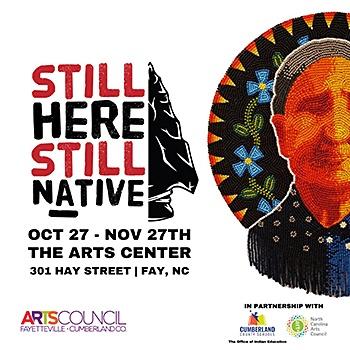
The curator, Savanna Davis, came up with the idea to host a space where indigenous people could share their own stories. She went to the Office of Indian Education— which is part of Cumberland County Schools — and they agreed to partner for the exhibit.
“I came to them with the concept, they said they loved it, and we [worked] it out together, and it all came together,” Davis said.
Eighteen indigenous artists have contributed to the collection of native-based artwork. Davis said that many of the submissions seemed to surround similar themes of identity.
“There are pieces about identity ... living in two worlds,” Davis said. “You have a tribal identity, and then you have a present-day identity, and those may not overlap all the time.”
Some pieces are heirlooms like a piece of local Lumbee Regalia, a quilt made for a couple on their wedding day, and bead embroidery. Then there are new art pieces, like a traditional cape made out of plastic bags and moccasins made out of plastic.
“It’s kind of new world technique meets old world tradition,” Davis said.
The artwork also shows the not-so-nice side of history. For example, one piece of art, “The Broken Necklace,” is about residential schools and how indigenous children were taken away from their homes and forced to abandon their culture and language.
A couple of other pieces of art focus on the Missing and Murdered Indigenous Women epidemic. According to the National Crime Information Center, 8,162 Indigenous youth and 2,285 Indigenous adults were reported missing. Murder is the third leading cause of death for Native women according to the Urban Indian Health Institute.
“We wanted to take the time to give it its own space,” Davis said.
In this corner of the gallery hangs a woman’s shawl with red handprints — the symbol of the MMIW movement. In the gallery booklet, there are also resources people can look up to learn more about the movement.
One interesting thing about the exhibit is that next to each piece of art is a QR code. That QR code leads visitors to a Wikipedia page that gives more information about the tribe where that piece of artwork comes from.
When you take a step back and look at the gallery as a whole, you see that this art reflects a thriving culture — not a history textbook.
“I hope people come in and learn something. I hope that it challenges what they think of when they hear Native Americans or Indigenous people. I hope it helps to make these cultures real and relevant and present. The way we traditionally encounter these cultures is in the dinosaur bones section in the museum so I hope this reverse that,” Davis says. “They are still thriving. It’s gorgeous, it’s incredible.”
The exhibit will be on display at the Arts Council until Nov. 27. The exhibit is free and open to the public.